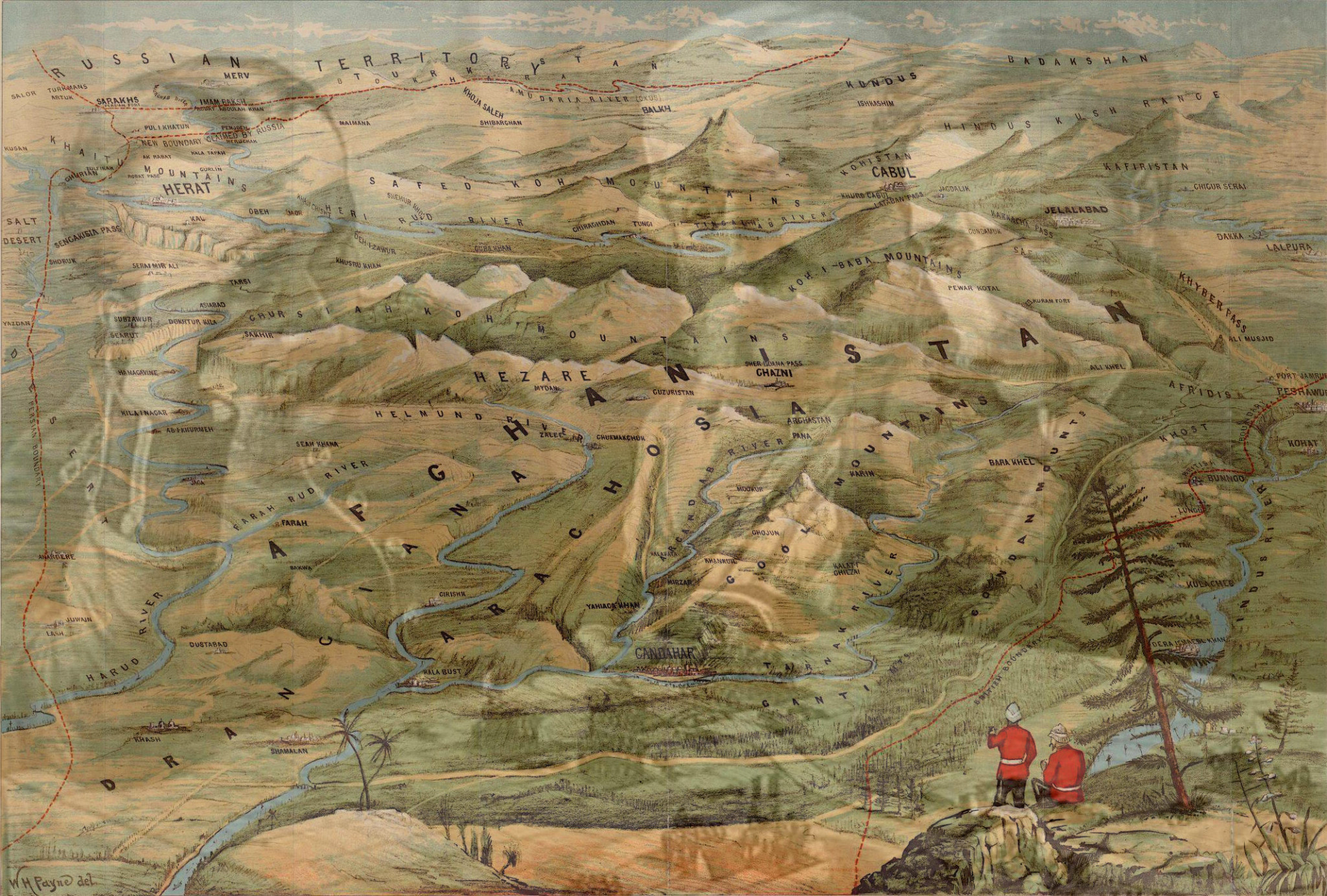by Tariq Marzbaan for the Saker blog
Subsequent to Part I of this essay on Afghanistan and the Taleban, I would like to embark on a brief history of "Afghanistan" leading up to Pashtun nationalism and the rise of the Taleban, through which one might better understand the "Taleban phenomenon" and which will also offer a view on the 3rd and final perspective ("from the perspective of Pashtun tribal structures and their 'national' identity").
* * *
The curse of colonialism.
The ideology of colonialism has always endeavoured to detach the colonised peoples from their ancestral and civilisational resources in order to subjugate and dominate them - not only economically and politically, but also culturally intellectually and psychologically. Consistent with their maxim "divide and rule", colonialists all over the world drew up borders to their advantages; they partitioned countries and regions, renamed and redefined them. These "new definitions" then moulded the viewpoints of the inhabitants of the colonialist states and these viewpoints were and continue to be transmitted to the whole of global society through various media channels, publications and education. And these viewpoints were not exclusively embraced by colonial nations - they were also adopted by large parts of the colonised societies themselves, who henceforth began to see themselves through the eyes of the colonisers
In this way, false identities were manufactured - on ethnic, national, and also on individual levels. (The notion of "exoticism" in colonialist societies is a good example of this. but that's a topic deserving of a separate essay.) In this context, I would like to refer the curious reader to the inspirational book "Orientalism" by the great Edward Sa'id, who was the first (as far as I know) to approach this subject scientifically.
It is thus essential that the inhabitants of regions where colonialism has been wreaking its havoc on indigenous cultures to this day (colonialism does not just belong to history) become aware of these circumstances and investigate the causes and roots of the false identities foisted upon them.
The discourse on identity has been a dominant subject that has occupied many intellectuals for quite some time in the fields of not only art and culture, but also politics, sociology, psychology and philosophy. Originally a topic debated by the classical left and progressives (as well right-wing reactionaries), the issue of "identity" was hijacked along with many other relevant topics by the neoliberal-colonialist globalists and distorted for their own purposes. The result is LGTBQ+, genderism, trans-speciesism, etc.
One of the regions where colonial interventions have had a significant impact on the history, geography, culture, mindset and ultimately the lives of the people is Afghanistan
What is Afghanistan and who are the Afghans?
"Afghanistan" - the name and the construct
In most history books and publications, in which Afghanistan is mentioned, it is presented as an original country and a unified nation as though it has always existed - in its current form and constitution - since the beginning of human history. This gives the construct named "Afghanistan" and the "Afghan nation" a false legitimacy and creates a false identity.
I do not want to discuss the concept of "identity" as a general or individual phenomenon, but prefer to focus on the "identity of a group" that individuals form together within a group in order to distinguish them from other individuals in other groups. A group can encompass a nation, an ethnicity (a "people"), a language, a culture, a religion, an ideology, a gender, a social stratum or class. Here I simply want to examine the notion of an "Afghan identity".
The nation and country of "Afghanistan", with its current borders and constitution, has in reality only existed for about 100 years Yet international historians and researchers cite "1747" as the year of the official foundation of Afghanistan. In that year, a Pashtun khan from the Abdali tribe in Kandahar was crowned king and is considered the "father of the modern state of Afghanistan". His name was Ahmad Khan Abdali, later known as Ahmad Shah Dorrani. When Ahmad Khan was elected king of the Pashtuns, he called himself Ahmad Shah, King of "Khorasan"* (see description of "Khorasan" further head) and not King of Afghanistan. At that time, there was no region, no country, no state called "Afghanistan", while there were some people identified as "Afghans" by others. The area inhabited by these so-called "Afghans" covered a mountain range known as the Sulaiman Mountains, between Kandahar in the south of what is now Afghanistan and Peshawar in the east of what is now Pakistan.
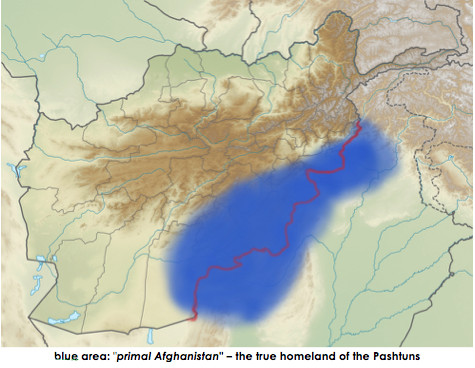
The term "Afghanistan", as opposed to "Afghan", appears in two historical documents - in the 14th and 16th century in the "Chronicle of Herat" (or the "History of Herat") by "Saifi Herawi" ca. 1321 and in the "Baburnama", the book of Babur, the conqueror and founder of the Moghul Empire in India, written by himself in the Chagatai language. However, the "Afghanistan" in these two books refers precisely to an area along the Sulaiman Mountains in which the Pashtun tribes lived at the time and not to the geographical entity of the "Afghanistan" we now know today.
If the Pashtuns around Ahmad Khan had wanted their own empire with their own names at that time, they would have most probably called it "Pashtunestan" and not Afghanistan, because "Afghan/Afghanistan" were foreign terms for them - bestowed on them by the non-Pashtuns. The name "Afghan" or "Aughan" was used in everyday interactions in Afghanistan both in the past and the present only in reference to the Pashtuns.
Ahmad Shah had originally intended to rule over the entirety of Greater Iran, including Khorasan*, and eventually extend his empire further east into India and further north beyond the Oxus. But in the end he only advanced as far as Mashhad in the west and the Amu Darya (the Oxus) in the north. He was mainly focussed on conquering India [More on this later].
The Pashtuns have always been either part of the Greater Iranian Empires (those of the Parthians, Achaemenids, Greeks, Sassanids until the end of the Safavid Empire), or under the hegemony/influence of the other ruling empires in the north and east, such as the Mauryas, Kushans, or the Mughals.
Pashtun society has always been organised by archaic tribal structures, the core of which is the tribal codex "Pashtunwali" (Pashtunism), which is still valid for them today. All historical documents that mention "Afghans" all mention the same characteristics - namely that the Afghans are warlike, brave, freedom-loving people who, when they are not functioning as mercenaries in the service of a king or emperor, make their own areas unsafe by conducting sudden raids or engaging in their everlasting tribal feuds and fighting amongst each other.
The Pashtun elites (known as "khans") generally assumed the position of commander of their own troops, which operated as mercenaries in the service of the courts of the Persians and Indians or of the local princes and rulers in the region.
The Pashtun population is divided into several main tribes, and the tribes into many smaller sub-tribes and clans. The two principle tribes are the Ghelzâyi tribe and the Abdali tribe (later renamed the Dorrani tribe). The Ghelzâyis were traditionally closer to the Mughal Dynasty, while the Dorranis had connections to the courts in western Iran.
Ahmad Khan Abdali (a young man from the Pashtun aristocracy) was a leader of the Pashtun troops in the Safavid army and later served as a close confidant of Nader Afshar (the successor of the Safavids) and accompanied him in his campaign to India. After the fall of Safavids and the death of Nader Afshar, Ahmad Khan claimed power and established his own rule over the eastern Iranian territories (in Khorasan*, now Afghanistan).
Normally, Pashtuns in the service of a dynasty retreated to their ancestral territory when the dynasty was overthrown or when it collapsed and waited for circumstances to clear and a new power to take over. Ahmad Khan, however, decided to found his own empire. Some Afghan historians attribute this to the influence exerted on him by the British - through one of their agents, a pseudo-Sufi mystic named Sabershah Kaboli who is said to have influenced the young Ahmad Khan. Likewise, his later campaigns and conquests in India are attributed to the influence of the British. Through Ahmad Khan, the British, wanted to weaken or even completely eliminate the Indian principalities, especially the powerful Maratha and Mughal dynasties, as well as the Sikhs - who were all hostile to the British - in order to then occupy India themselves without having to encounter any significant resistance. These steps were taken and paved the way for British colonial rule over the whole of India under the name of the "British East India Company".
The British then introduced and propagated the name "Afghanistan" throughout the world for the territory of Khorasan and the term "Afghan" for the entire Khorasan population - even before the Pashtuns ever used these terms themselves. All Pashtun rulers had used the name "Khorasan" for their territory until the mid-19th century. The Viceroy of British India, Lord Auckland, had officially introduced the term "Afghanistan" for the first time in a letter to the Pashtun king Shah Shuja Dorrani (reign: 1839-1842), while Shah Shuja continued to use the term "Khorasan" in his writings. In paragraph 4 of the Treaty of 7th May 1839 between Shah Shuja and the representatives of Lord Auckland, it was stated, amongst other things, that the official name of the country from then on was to be "Afghanistan".
As can be observed here, a gradual and insidious process - owing partly to a natural course of historical events and partly to strategically deliberate ideological and geopolitical agendas, coupled with military brute force (war) - was what led to the creation of a state and country (in the political sense) called "Afghanistan". From a distance, the process seems almost fortuitous. And the world today has simply accepted the existence of this state as a matter of course. In the official narratives recounting the foundation of "Afghanistan", the population of this state is presented as shadowy, savage beings who have never had any influence of their own on the outcome of this process.
It was Amir Abdul Rahman (reign: 1880-1901) who first accepted the name "Afghanistan" for his state and adopted it himself. The population, of course, was never consulted.
In 1919, the Treaty of Rawalpindi recognised Afghanistan's independence from the British government and established the name "Afghanistan" internationally.
In 1935, at the instigation of Persian King Reza Khan (the founder of the Pahlavi Dynasty), the parliament in Tehran decided to establish the name "Iran" internationally politically for the country, which until then had been known in the West as "Persia". But before this intention was to be announced internationally, Reza Khan sought the consent of the Afghan government, as he was concerned that the Afghan side, especially the population, would lay legitimate claim to the names "Iran" and "Khorasan".
The Afghan King Zaher Shah readily welcomed these intentions of the "Persians" and renounced the name "Iran" for Afghanistan - a move, which was criticised by the non-Pashtun elites of Afghanistan.
Why the name of the country/state (and also the Persian language) was and still remains so important to the non-Pashtun people - especially those engaged in politics and culture - has to do with their cultural and historical identity and with their perpetual opposition to the efforts of the (Pashtun) state to impose an identity on them other than their unbroken "Persian-Iranian" identity that had evolved and established itself over millennia.
To get a better understanding of this complex predicament, one must look back further in history to explore the geography and some of the cultures of this region
*Khorasan - "The East" or "Land of the Rising Sun"
The Sassanid Empire was divided into four major administrative regions. The eastern area was called "Khorasan" (Middle Persian for "The East") "Khorasan" literally means "Land of the Rising Sun".
Today's Afghanistan covers most of the area of historical Khorasan. The name "Khorasan" persisted until the 19th century as a general term for a region that repeatedly expanded or contracted over time and was divided amongst satrapies and principalities that were either directly or indirectly under the rule of various empires and great kingdoms while it always belonged to the linguistic and cultural sphere of Greater Iran and formed the eastern flank in the Iranian plateau for the Persian empires.
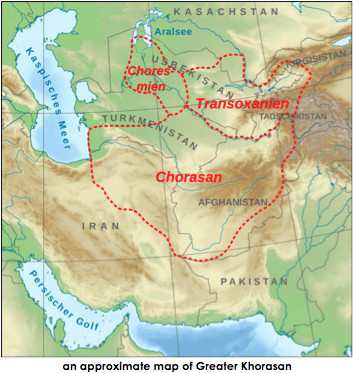
All the rulers in this area identified themselves as either King (Shah) of Iran or King (Shah) of Khorasan - whenever their domain was limited to the territory of Khorasan. Today, three provinces in Iran (two of them on the border with Afghanistan) bear the name "Khorasan" (North Khorasan, South Khorasan and Razawi Khorasan).
Historical Khorasan never had fixed borders. It extended north to Central Asia beyond the Amu Darya (Oxus), south to the Arabian Sea (Baluchistan), east to Peshawar and Moltan, and west from Nishapur to Kerman. Merw, Balkh, Herat and Nishapur have often been named as the four principal cities of Khorasan. Some Islamic historians and geographers of the Middle Ages also included the cities of Samarkand and Bukhara, even Kashgar (in Xinjiang, China), as belonging to Khorasan.
The frontiers of the Sassanid Empire were constantly subject to invasions by neighbouring empires and raids by nomadic tribes. Thus, Khorasan was also repeatedly exposed to India's expansionist efforts and incursions by nomadic tribes from China and the Central Asian region. Whenever local resistance proved unsuccessful in its defence of their area, the central government would come to the aid of the local Marzbaan (a Sassanid "governor") with substantial military contingents. Such an mission was sometimes even led by the emperor himself.
In many of these wars, control over the trade routes (the Silk Road) played a significant role.
Khorasan - battlefield of nations and melting pot of cultures
In short, Khorasan (and its present-day equivalent) has always been the battleground of empires, kings, tribes, peoples and individuals who were either indigenous to the region or who invaded Khorasan from all directions.
Although Khorasan originally belonged ethnically, culturally and historically to Greater Iran, in the course of time many other peoples, tribes and tribal associations from outside founded their own kingdoms there or occupied parts or all of Khorasan for brief or longer periods or simply incorporated it into their sphere of influence. These circumstances have consistently determined and influenced the fates of the people of Khorasan until today.
Khorasan was not only the eternal battlefield of nations, but also the melting pot of cultures. All the invaders, migrants and emigrants who stayed in Khorasan (be it for shorter or longer periods) - who settled there and made it their home or brought it under their rule - have left their marks
The population of Khorasan, as far as present-day "Afghanistan" is concerned, evolved into a broad variety of ethnic groups, some of which moved into the area over time. The main ethnic groups were composed of Persian-speaking peoples - now called Tajiks and Hazaras (descendants of Mongols), Turkmen, Uzbeks (both Turkic peoples). Pashtuns, Baluchis and Alans (known today as "Nuristanis"). There were also Arabs and Kurds. In the course of invasions and conquests, the gene pools of the population were also refreshed again and again, and new components were added. Today, no one in the region of historical Khorasan can claim a "pure" descent from one sole specific ethnic group with certainty. While designations like "Aryan", "Indian", "Turk", "Arab", etc. lose their specific "ethnic" references in Khorasan and can only imply a cultural significance, the visual appearances of the peoples there testify to their diverse, different backgrounds of descent.
Khorasan also accommodated the Hindu Mauryas, the Buddhist Kushans, the Hellenistic Greeks, the Muslim Arabs, the pagan Mongols, the predatory Turkic tribes, the Christian colonialist British, the Russians (Soviets) and last but not least the imperialist USA and its NATO vassals.
The list will probably be extended in the unforeseeable future.
The persistence of the Persian language and culture
The upheavals and radical changes in this region continue to this day, interposed with sometimes shorter, sometimes longer periods of calm. Despite all the invasions, wars, destruction and periods of foreign rule, the spirit of ancient Iranian culture has always managed to survive in Khorasan, rising again and again like a phoenix from the ashes in the body of the "Dari-Persian" language.
All foreign and local rulers of other cultural origins and native tongues left Dari Persian untouched in Khorasan as the official language, for their literature and as their "lingua franca". Some of these foreign ruling dynasties even made names for themselves by promoting and disseminating the Persian language and its literature.
The Sassanid king Bahram Gor (421-438 AD), in whose home province of Pars the Middle Persian language (known as "Pahlavi Persian") was widely spoken, elevated Dari Persian - which had in fact evolved from Middle Persian in Khorasan - to the status of the court language and the official language of the entirety of the Sassanid Empire.
Only two ruling systems attempted to eradicate Dari Persian from the region: the Arab Caliphate, when it occupied Greater Iran (including Khorasan) in the 7th and 8th centuries and the Pashtun state, since the beginning of the 20th century in what is now "Afghanistan". And this recent assault on the Dari-Persian language remains ongoing. (The conversion of the Persian script to Cyrillic in the Soviet Republic of Tajikistan undoubtedly impaired the further development of the Persian language in Tajikistan).
Following the fall of the Sassanids in the 7th century, the Arab armies first occupied western Iran and gradually the rest. After the conquest, the Arabs introduced an administrative system modelled on the Sassanids. Initially, everything written in the administrative authorities was in Persian.
But the Umayyad ruler Abd al-Malik ibn Marwan decided to change the language in the Divan (the administration) from Persian to Arabic. This marked the beginning of the "Arabisation" of the conquered territories. The Umayyads, for all intents and purposes, practised a chauvinist to racist apartheid policy in all societal spheres against the defeated Iranian peoples. The use of the Persian language was penalised, and Arabic was deemed the sole official language. From then on, all matters in administration, science, literature and other fields involving correspondence were to be conducted solely in Arabic; violators were to be punished. Nevertheless, the population persisted in speaking Persian at home on the streets and in the markets. This repression of the Persian language ultimately led to insurrections and revolts.
During the Umayyad period, the foundations were laid for the "Arabisation" of parts of the Islamic Empire - known as the Arab World today: the whole of North Africa and part of East Africa, parts of the Gulf region and the entirety of West Asia up to the western border of Iran. Here one can speak of a kind of "Arab colonialism".
It was the uprising conducted by Behzadan Pure Wandad Hurmuzd, better known as Abu Moslem Khorassani, that eventually brought about the overthrow of the Umayyads and the founding of the Abbasid Dynasty by Abu Moslem himself (in 750 AD).
It was not long before other Iranian peoples rose up against the Arab rule and established their own states. The Tahirids (821-873) were the first dynasty to declare independence and establish their own state in Khorasan (with Nishapur as their capital). During their rule, the Persian language was gradually revived in the field of literature.
Yaqub Layth Saffâr, from Zaranj (a city of the Sistan region - today south-west Afghanistan) was the founder of the Saffarid Dynasty (861-1003), who succeeded the Tahirids, ultimately abolished the domination of Arabic in literature and in the administration by banning the language throughout his empire. Nevertheless, Arabic continued to be employed in scientific fields for some time.
It was under the Samanids (819-1005) and the Ghaznavids (997-1186 - a dynasty of Turkic origin), that Dari Persian reached its golden age. The great epic written in the Persian language and an almost sacred book for nearly every Persian-speaking person knowledgeable of history and culture is the "Shâhnâma" (in Iran pronounced "Shâhnâmeh" - "The Book of Kings"), written by Abol-Qâsem Ferdowsi Tusi (940-1020) in roughly 60,000 lines and in the style of Mathnawi poetry, which recounts the mythical and historical past of Iran from the creation of the world until the Arab-Muslim conquest in the seventh century.
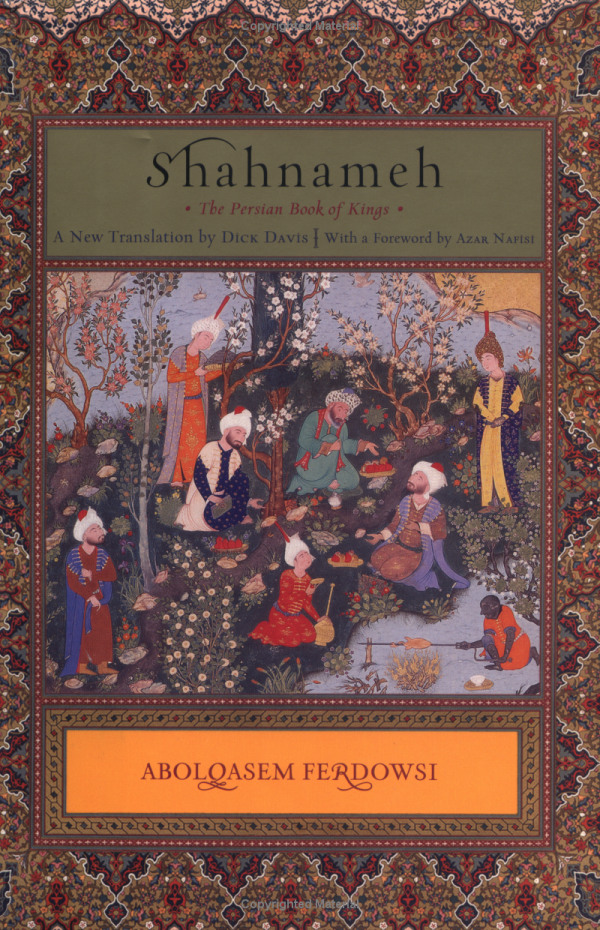
The descendants of the Mongols brought the Persian language to India and established it as the language of science, literature and their administration throughout the domain of their so-called "Mughal Empire". The region in which Persian was used as the lingua franca and as an official and cultural language extended as far as India and to Northwest China, as well as into the Caucasus, Asia Minor and the Balkan states. In the Ottoman Empire, Persian (later alongside Turkish) was the official language until Kemal Pasha (Atatürk) abolished it.
For the people of Khorasan, the question of whether the ruling dynasty, government or state was their own or a foreign one never played a major role, as the opposite is so often claimed. Greeks, Hindus, Arabs, Turks, Mongols and Uzbeks ruled Khorasan alternately for centuries. And all foreign conquerors and occupiers who ruled there for decades or centuries and wanted to retain Khorasan as part of their empire or kingdom, would have had to ensure a degree of social peace and stability for their empire to survive.
All rebellions against occupying powers and hegemons in the region occurred for economic reasons (famine, high taxes, poverty, etc.) or because of brutal oppression, corruption and/or despotism of the power apparatus and a lack of jurisdiction. The foreign rulers of Khorasan were thus obliged to rely on the human resources and social structures of the local population that were already in place.
Indeed the ruling dynasties in this region often did not hail from the local population. But as long as these rulers vouchsafed, supported or went so far as to even promote the Persian language and culture and guaranteed social and inter-ethnic justice, they were accepted by the population. But as soon as these criteria were violated, popular resistance would break out, which, depending on the circumstances, could even lead to full-scale conflict.
All the conquerors never had a "plan B" for the period of their power In order to maintain and administrate Khorasan, they were obliged to rely on local populations and their elites - who were Persian-speaking Iranians and it was not long before the Khorasan people became the veritable administrators and, as is often the case, the veritable "rulers" of the empire.
Following the Timurid Empire (1370-1506), Khorasan gradually lapsed into cultural decline and poor governance - circumstances that only worsened during the Safavid Era and scarcely improved under the two hundred years of Pashtun rule until today
Religion in Khorasan
Over the centuries, Khorasan also adopted a great variety of religions: polytheism, Mithraism, Zoroastrianism, Zurvanism, Manichaeism, Hinduism, Buddhism, Islam
Western Iran (today's Islamic Republic of Iran) was conquered and Islamised relatively quickly by the Arabs, while large parts of eastern Iran (Khorasan) resisted Islam for centuries. The last non-Muslims, the Kalash, called "Kafaran" or "Kafirs" (infidels) by others, were only "converted" to Islam in the 19th century by the despot Amir Abdollrahman, and their land was renamed from "Kaferestan or Blurestan" to "Nuristan" ("land of light"). Like the Pashtuns, the majority today are devout Muslims. But a minority (now in Pakistani territory) still retain their Dravidian faith.
Religion and faith have always played an important role in Khorasan. But the peoples there always gravitated more to a universal spirituality rather than to a dogmatic, fundamentalist version of Islamic religion and ideology (as an organised, fixed, limited system).
The people of Khorasan, regardless of their ethnic and linguistic affiliation, converted to Islam but retained aspects or key elements of their earlier beliefs and traditions And in order for these "vestiges" to remain viable, they were either gently tinged or vigorously blended with the prevailing "hues" of Islam.
Spiritualism, which has its roots in pre-Islamic religions and cultures, gave rise to numerous mystical Sufi schools, orders and sects over time. Islamic Sufism and mysticism (Tasawwuf/Erfân - mysticism/Sufism) in Iran is an amalgamation of Islam with Iranian pre-Islamic faiths comprised of the Zoroastrian religion, Mithraism, Zurvanism, Manichaeism including elements of Hinduism, Buddhism, Greek mysticism and philosophy (especially stoicism, neoplatonism) and Christian Nestorianism.
The Rise of Pashtun Nationalism and the Pashtunisation of Afghanistan
From the 16th century, the Safavids (1501-1722) ruled Iran and large parts of Khorasan. They established the Shia denomination as the official dominant denomination throughout the country and transformed Iran into a theocratic state. This policy led to disastrous, fatal consequences and finally to their downfall with the Pashtun uprising. Until then, Iran had been known for its high level of tolerance, especially with regard to religion. This policy, exacerbated by other repressive brutal acts, led to an alienated society and resistance to the ruling apparatus. Amongst the various societal groups, the Sunnis - which included the Pashtuns - found themselves particularly discriminated against and oppressed.
In 1721, Shah Mahmoud Hotaki of the Ghelzâyi tribe rose up against the central government in Kandahar and the occupation of Isfahan to put an end to the Safavid dynasty. Following Shah Mahmoud Hotaki, his cousin Shah Ashraf Hotaki, who ruled Isfahan until 1729, fought battles against Ottoman troops in the west and Russians in the north to defend the integrity of Iran. Thus the Pashtuns still saw themselves as an integral part of the Iranian Empire.
But the Ghelzâyis could no long assert themselves and were unable to fend off the increasing number of renegade claimants to the throne who had risen from all corners of the empire.
Then a powerful and adamant Safavid general, Nader Afshar, appeared on the horizon. With the help of the Pashtun Abdali tribe - who were competing against the Ghelzâyi tribe, he defeated and drove out the Ghelzâyis, retook Sistan, Kandahar and Herat and crushed his rivals.
In pursuit of the Ghelzâyis, who had retreated to India, Nader Afshar, by now Nader Shah, marched into India, defeated the Mughal army and captured Delhi. In this campaign he was accompanied by Ahmad Khan Abdali and his Pashtun troops.
But in his eleven years of rule, Nader Shah proved also unable to pacify and stabilise the empire. Iran had long since sunk into feudalistic civil war and chaos. In 1747, he was assassinated by his own officers, and the civil war intensified.
Ahmad Khan Abdali, commander of the Pashtun troops in Nader Shah's forces, set off to Kandahar, had himself proclaimed king by the Pashtuns and changed the name of his tribe from "Abdali" to "Dorrani". (Why he did this is not documented and the reasons are disputed amongst historians.) "Ahmad Shah Dorrani" achieved considerable conquests north to the Oxus and east to Delhi.
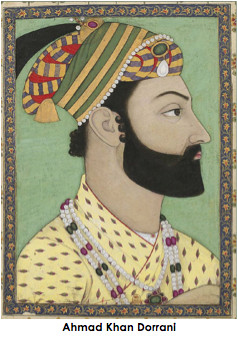
The conquest of Khorasan by Ahmad Khan Dorrani and the formation of a new kingdom followed an old feudalist "tradition" that is: as soon as a local feudal ruler sensed the weakening of the central government (a ruling feudal dynasty that had subjugated the local rulers - in this period: the Safavid dynasty), he would sprang into action to either increase his sphere of power and privileges, weaken or eliminate his unemployable neighbouring rivals and, if possible, found a new kingdom or even overthrow the ruling principal power and establish a new dynasty with a claim to rule over the entire empire. The phenomenon of the "warlords" and the Pashtun claim to autocracy in today's Afghanistan are testimony to a feudalistic system that still exists in parallel to "modernity" (capitalism) in that country
A new dynasty (the Dorranis in this case) would emerge and it would expand its empire until it either managed to consolidate its power and establish a long-lasting rule or it would be overthrown by yet another power-seeker who would establish a new dynasty. All else would simply remain the same.
However it was during this time that new players with their own interests appeared on the stage - the modern European colonial powers: the British, the Russians, the French, the Portuguese, the Dutch, etc. In the end, only the first two were able to hold their own in the region and compete against each other in the final battle on a regional stage, as well as on the international stage. The Great Game was born.
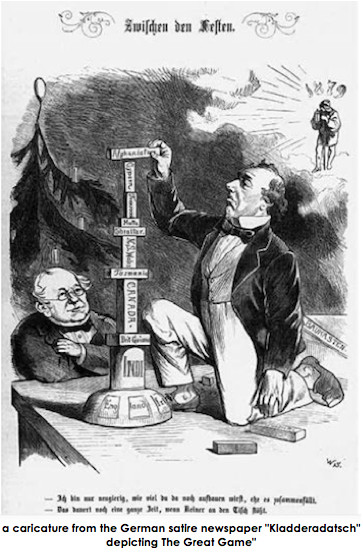
Their aims for domination and the colonisation of Central Asia and India threw the entire region out of balance and brought about new relations and associations. The separation of the eastern part of Greater Iran from the rest became definitive.
After the death of Ahmad Shah Dorrani, his son and successor Timur Shah Dorrani (1773‑1793) struggled to hold on to a large part of his father's legacy. After his reign, the region was plunged into a bitter civil war, and a fratricidal power struggle erupted amongst numerous Pashtun princes and the sons of Timur Shah, each against the other.
The British and the Russians intervened in this rivalry with great determination, supporting the one against the other, depending on the potential advantages they could reap.
These circumstances lasted until 1880, when Abdul Rahman of the Barakzâyi clan came to power with the help of the British. He put himself at the service of the British Empire and undertook to defend British interests in return for financial aid. Afghanistan thus became a British semi-colony and protectorate.
Abdul Rahman is regarded in the official historiography of Afghanistan as the founder of "modern" Afghanistan. Indeed, it was with him that the Afghan state took on the form it has today.
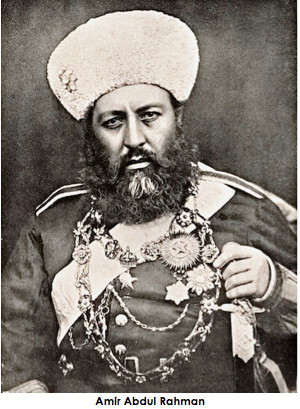
Amir Abdul Rahman unleashed a reign of terror to establish a graveyard peace throughout the land. The Hazara population suffered the worst under his tyranny. After this population dared to protest against increased taxes, he organised a large-scale massacre in which thousands fell victim; their belongings were looted by the Pashtun tribal warriors; Hazara women and children were sold as slaves in the markets, and part of the population was sent into exile to India (now Pakistan), where the Hazaras still have a community today - in the Pakistani city of Quetta. These events, which bordered on genocide, still traumatise the Hazaras to this day.
On the advice of his British advisor Colonel Yeats, Amir Abdul Rahman launched the first settlements of the Pashtun tribes in the non-Pashtun areas of central and northern Afghanistan.
This was one of the first steps towards the "Pashtunisation" of Afghanistan, even though the amir and the other Pashtuns were not yet instilled with a Pashtun nationalist consciousness and did not yet have a systematic agenda. Full-fledged Pashtunisation, with an established ideology and a programme, began only after 1919, when King Amanollah won full independence for Afghanistan from Great Britain.
In the early 20th century, many Afghan students were sent to Europe, particularly to Germany, to study. There they became acquainted with various Western political ideas and ideologies - including National Socialism. From this time onwards, some Pashtun scholars and intellectuals began to cultivate notions of (Pashtun) Aryanism, and with this new (distorted) consciousness, conceived of a fusion of state rule mixed with the culture of Pashtun tribal society, which they promoted as an "exceptional nation".
Returning to Afghanistan, they found fertile ground for their aspirations amongst the ruling circles in the government. King Amanollah himself was enthusiastic about the Germans and Italians because of their anti-British stance.
Amanollah's son-in-law and foreign minister, Mahmoud Tarzi, who had spent time in Turkey and Europe from his childhood until the age of 35 and could hardly speak a word of Pashto, was infatuated with the idea of Pashtun Aryanism and suddenly wanted Pashto to replace the Persian language throughout Afghanistan. Several attempts by Pashtun governments to fully pashtunise Afghanistan had failed so far due to the resistance of the Persian-speaking population. (After 2001, Karzai and Ghani resumed these plans, which is another reason for the rapid collapse of the state).
However, under King Mohammad Zaher (1936-1973), a slow and creeping language policy was undertaken in favour of the Pashto language and Pashtunism, which did much damage to the cultural and spiritual development of the population for generations. History was heavily rewritten or censored. Publishing in Persian was prevented or made difficult. All state employees who were not Pashtuns were required to attend weekly Pashto-language classes; those who refused or did not attend regularly had their salaries cut. Mohammad Goll Mohmand, a high-ranking official and an ardent Pashtun nationalist when he was State Commissioner for Northern Afghanistan, ordered the abrasion of stone inscriptions of some historical testimonies that were in Persian. He was obsessed with the elimination of the Persian language and culture in Afghanistan.
In the era of Mohammad Zaher Shah, the attitude of a considerable number of members of the royal clan, who had been brought up in a Persian-speaking environment and who did not speak Pashto, regarded their Pashtun society with its tribal culture as backward and were critical of the government's educational and cultural policies. Thus the "Pashtunisation policy" was not consistently pursued by the government.
The subsequent fall of Zaher Shah in 1973 ushered in a turbulent period of upheavals, revolts, conflict and civil war, which more or less continues to this day. In 1994, a coalition of the Mujaheddin from various parties and opponents of the propped-up PDPA government under Najibullah, took power in Kabul. These forces all happened to be non-Pashtun.
Gulbuddin Hekmatyar, a Pashtun Islamist, Muslim Brother and leader of the "Islamic Party", did not accept a government led and predominantly occupied by non-Pashtuns and thus took up arms against them. His actions led to a civil war with many dead, numerous refugees, a destroyed Kabul and his own undoing.
An Afghan state led by non-Pashtuns was also fully unacceptable to the Pakistani ISI. To restore power to the Pashtuns, they came up with the idea of creating the Taleban.
The ethnic conflict and the Pashtuns' sole claim to state power in Afghanistan were and remain the true rationale behind the Taleban movement, its militancy and its rise to power.
Following the overthrow and expulsion of the Taleban in 2001 by the USA/NATO and their Uzbek and Tajik helpers, the USA installed Hamed Karzai, a Dorrani Pashtun and a member of a drug-dealing mafia family, in power. He was imposed on the government by the US during the Afghanistan Conference in Bonn in 2001 in a coup-like action against non-Pashtun candidates.
Throughout the 20 years of their presidencies, Karzai and Ashraf Ghani (a chauvinist Ghelzâyi) were much more involved in sabotaging the opposition against the Taleban, corrupting non-Pashtun incumbents (especially in the security agencies) or removing them from office through intrigues (and where intrigues did not work, they resorted to violence and physical removal).
Now the Taleban are in power
The entire country of Afghanistan is now under the control of the Taleban. And the Pashtunisation of Afghanistan has entered a new phase. This time the Taleban are determined to finish the job. Their ranks comprise many older and new followers of "Pashtun exceptionalism" who cultivate a "Pashtunen über alles" ideology. The displacement of populations in non-Pashtun areas has now become commonplace.
The Persian language is being cancelled and has all but disappeared from official notices, road signs, the media, official documents and the correspondence between administrating authorities. Citizens visiting administrative offices to settle their affairs are treated with hostility if they do not speak Pashto.
The fact that in all these 20 years the Pashtun Taleban have fought and sacrificed themselves against the US/NATO occupation, while others have either joined hands with the occupiers or simply not participated in the battle, makes them feel even more self-righteous and contemptuous of the non-Pashtun population.
The (calculated) withdrawal of the US and the Taleban's alleged "victory over 30 nations", has only inflated the self-image of the Pashtuns in general and the Taleban in particular, as they now see themselves as invincible heroes.
There is not much to report about the anti-Taleban resistance amongst the Tajiks. It is weak and without strong leadership and noteworthy support. Their leaders inside and out of the country are all corrupt officials and dignitaries of the overthrown regime who have lost their integrity and their influence amongst the people. The Hazaras and Uzbeks (also leaderless) have remained silent so far. The Hazaras in particular still seem to be in a state of shock
One can only wonder why the Persian-speaking Tajiks failed to win over the Pashtuns to accept and perpetuate the Persian language and culture as they did in the past. (This topic deserves its own study, as it has not yet been adequately addressed in research.)
The fate of the Persian language and culture in Afghanistan is ultimately of no interest to anyone (internationally) and is the sole concern of the people concerned.
As long as the Pashtuns do not relinquish their claim of ownership and imperious rule over Afghanistan, a peaceful, solidary coexistence between them and the rest of the peoples of Afghanistan will not be possible.
A favourite saying amongst many extremist nationalist Pashtuns is:
"The Tajiks to Tajikistan, the Uzbeks to Uzbekistan, the Hazaras to Gurestan (the graveyard)."
* * *
For the moment the crisis zone that is Afghanistan represents a major stumbling block for a united multipolar world in Eurasia and is thus, to put it mildly, a blessing for the unipolar Hegemon.
But no one knows the future. And there are always surprises bad ones but also good ones
* * *
For some further information:
Cheung2017_On_the_Origin_of_the_Terms_Afghanistan
academia.edu (requires registration)
